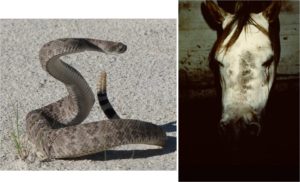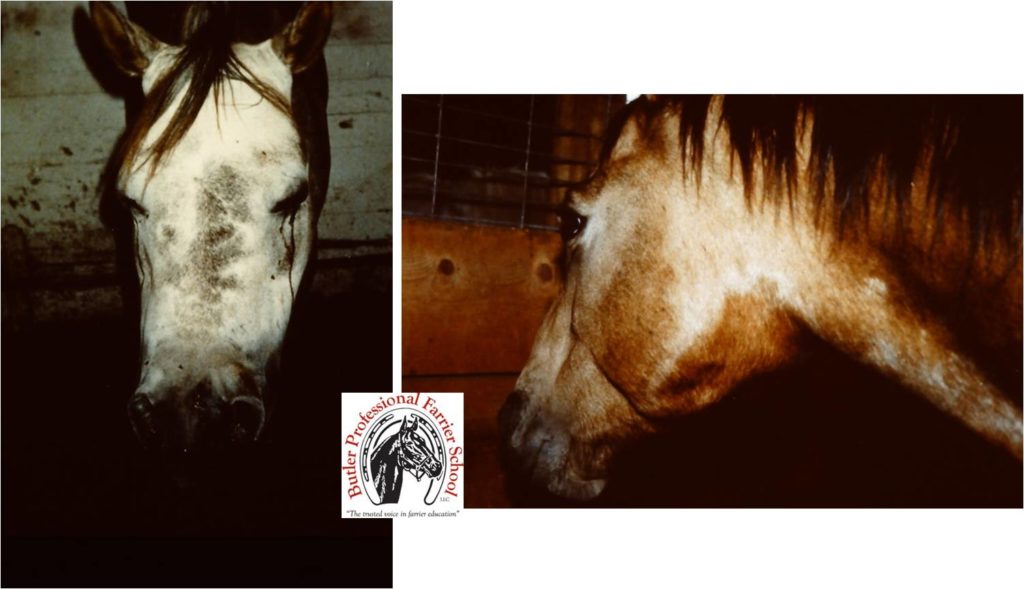Snake Bites in Horses

Snake bites can be lethal for horses. Left: Coiled Western Diamondback Rattlesnake (publicdomainpictures.net); Right: Horse that was bitten on the muzzle by a rattlesnake (photo credit: Doug Butler)
Only about 10% of snakes native to the U. S. are poisonous. Most of these are in the West and South. However, rattlesnakes are found in all the lower 48 states except Maine. Australia has the most poisonous snakes, spiders, scorpions, and jellyfish.
Several hundred horses are bitten annually by poisonous snakes in the U. S. with a mortality rate of 10 to 30 percent. Occasionally a horse will be bitten by a poisonous spider or a scorpion, but these are rare occurrences. Due to the size of the horse, snake bites don’t usually have the lethal effect they do on animals of smaller body size. The severity of the bite depends upon the volume and potency of the venom injected, the health of the victim, and the location of the bite. We had two horses bitten when we lived in Colorado. One survived and one didn’t. One was bitten on the jaw, the other on the tongue. The latter didn’t survive.
Many people do not understand the severity or seriousness of a snake bite. Our neighbor in Colorado was bitten on the foot by a rattler in her front yard. She nearly died. She was in the hospital for 10 days and treatment cost nearly $90,000. One of my former students from Colorado was bitten in the hand. Her hand swelled up to the size of a football. She was seven weeks in the hospital.
Even if a horse survives the initial bite, there is a good chance it may develop laminitis and founder later on. Apparently, the venom damages the laminae and causes the basement membrane to separate.
A former student from North Carolina told us of a case he dealt with where the hoof separated from the coffin bone and sloughed off. He made a boot to protect and medicate the exposed laminae and bone utilizing a soft frog support until the new hoof grew out.
According to Dr. Terry Swanson of Littleton Large Animal Clinic, Littleton, Colorado, reporting his experience at the 22nd convention of the AAEP in 1976, antivenin should be given to an affected horse within 6 hours. This often is not possible due to time of discovery, availability and expense of the drug. In addition, there may be an anaphylactic shock reaction. When possible, the dead snake should be brought in for identification.
Most horses are bitten on the muzzle. The soft tissue of the muzzle swells and shuts off the horse’s air. Without medical intervention, these horses will die from suffocation. Horses bitten on the lower leg are not as obvious at first. Pressure bandages on the extremities are better than a tourniquet to prevent the spread of poison according to Dr. Julian White of CSL, Ltd., Melbourne, Australia.
Bites are easily recognized if they are on the muzzle. First aid consists of placing a short piece of hose or modified syringe tube into the ventral meatus of the nostril. This can be held in place with a stitch.

Snake bites on the muzzle and nose are the most dangerous because the swelling can cause air passages to close and the horse can suffocate. The horse on the left was bitten in the muzzle. The horse on the right was bitten in the jaw. Swelling occurred in the throat latch area but the horse survived after heavy doses of antibiotics.
When the vet arrives, he or she will probably give a sedative to calm the animal and establish an adequate airway. The vet may cut into the windpipe, called a tracheotomy, to establish breathing until the swelling at the bite site goes down. The horse may not be able to eat or drink and require intravenous fluid therapy. Large quantities of antibiotics, usually penicillin, are administered over several days to prevent the action of the Clostridium bacteria in the venom. Anti-inflammatory drugs such as intravenous phenylbutazone (Bute) are given to control the cellulitis caused by the venom. Tetanus shots should be current. Bitten horses should be monitored closely for at least two weeks. Some die of complications after a week since the kidney, heart and other organs may be affected.
The venom affects the heart rhythm and there is often damage to the heart valves. The hemotoxin causes lysis (disintegration) of red blood cells. The extent of the damage can be determined by the vet with a stethoscope after the horse recovers. Be aware of the potential danger to yourself and your horse from poisonous snakes.
A rattlesnake vaccine (Crotalus Atrox Toxoid) by Red Rock Biologics of Woodland, California is available. Three shots are given – one each month for three months. The vaccine is intended to boost the horse’s immunity to defend against rattlesnake venom (redrockbiologics.com). This seems like a practical solution for those who ride and pasture their horses where there is a heavy concentration of Western Diamondback rattlers.
Related Posts
-
In the mid 70s, Dr. Doug Butler went to Cornell University t...Jan 30, 2015 / 0 comments
-
This past weekend (9 June 2018), Justify won the Belmont Sta...Jun 14, 2018 / 0 comments
-
We’ve had many questions about hoof supplements. The f...Jan 31, 2019 / 0 comments
Blog Categories
- Anatomy
- Best Business Practices
- Conformation
- Current Events
- Customer Service
- Draft Horse Shoeing
- Equine Soundness
- Essential Anatomy Kit
- Farrier Careers
- Farrier training
- Foal soundness
- Horse Care
- Horse Foot Care
- Horse Owner Tips
- Horsemanship
- Horseshoeing
- Horseshoeing History
- Iron and Forge Work
- Student Spotlight
- Uncategorized
- Veterinary Care
Blog Archives
Contact Us
Butler Professional Horseshoeing School
495 Table Road
Crawford, NE 69339
(800) 728-3826
jacob@dougbutler.com
Subscribe to Our Blog
Get Our Free e-Book!
If you think you want to become a farrier (or know someone who does), this book can help you make that decision. Horse owners will learn the importance of choosing a qualified farrier and how to select the “right” one.
[ Get the e-Book Now! ]
- Follow:
